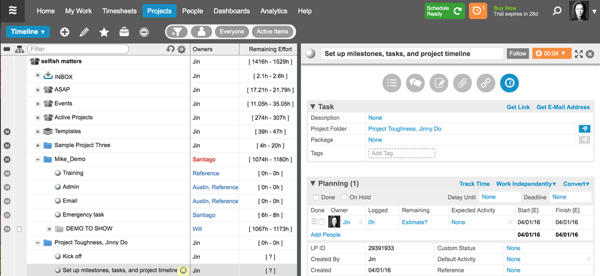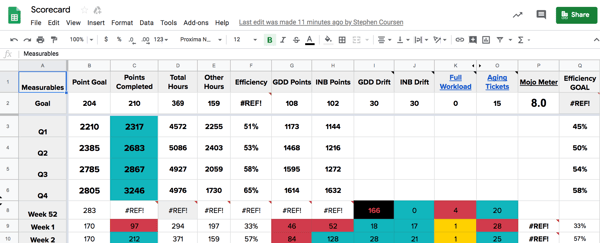For a company to be prosperous, everything needs to work.
You need to produce high quality products or services.
You must produce at an efficiency that you can profit from, on a schedule you can repeat.
Your employees must operate at their best.
And often, these primary components work against each other.
That's why a lot of companies, eventually, need a little guidance to improve team efficiency. You want your employees to be happy, motivated, and creative, but you can't sacrifice the quality of your product or service.
In our experience, improving efficiency without sacrificing this quality (or the happiness of your employees) starts with one critical thing.
The Secret To Starting To Balance Your Company Efficiency And Quality
The most successful companies have an overarching purpose or company philosophy. They tie everything to this purpose.
They hire employees that believe in this mission.
They create systems around this purpose.
They communicate this purpose to their team constantly.
For Netflix, it's “Values are what we value.”
For HubSpot, it's “We commit manically to both our mission and metrics.”
And before you can call me out and say, “Really, Melissa? A mission statement? That's it?”
No, that's not it.
Because to properly execute your philosophy, you also need to back it up with tools, systems, and resources. And with the right support in place, you can keep your team efficient, motivated, and fulfilled, while delivering an exceptional product or service.
That's why if my goal was to improve the efficiency of my team, while producing a quality of a product or service, this is where I would start.
1. A Baseline Of Current Performance
If you're struggling to measure your team efficiency, getting a baseline of your current performance is a great first step. It will require getting all of the information you possibly can about your existing employee workload and hours.
This can include information such as:
- Time tracking data, which you can usually get through tools such as Liquid Planner or Harvest)
- The amount of time typically needed to complete common projects or services, such as the amount of time spent on setting up a new client account or on-boarding.
- The hourly rate of your employees.
The more data you have the better. Otherwise, you may go off assumptions to begin with, which can skew your expectations.
For example, my workweek often looks like:
- Writing and Content Creation - 8 - 12 Hours
- Content Strategy - 4-6 Hours
- Client Communication - 3-4 Hours
- Website Strategy - 2-3 Hours
- Building Websites - 2-3 Hours
- Internal Meetings and Communication - 4-6 Hours
- Misc Admin Tasks - 4-6 Hours
Ideally, that information would come from a few months of time tracking. I'd create an average of the time spent on each overall task or objective and use that to measure my performance in the future.
However, if your employees don't track their time and you don't have a clear understanding on how long they're taking to complete tasks, have your team provide estimates on their most frequently done tasks.
From this, you can piece together their work week and create an estimate that may not be 100% accurate, but realistic.
2. A Mini-Audit Of Existing Projects
Once you have a baseline of performance and an understanding of how your employees spend their time, you can start tracking how long your projects take to complete.
If you don't have a system in place to track projects, you will need to do two things:
via PCMag
First, you will need to implement a project management system with time tracking. This will house all of your ongoing projects and track the progress and time spent on those deliverables. We use Liquid Planner, and I've always used tools like Wrike and Mavenlink that also work well.
Second, you will need to require your employees to track their time. Whether you have a remote team or an in-office team, time-tracking is a game changer. During the week, employees should track their time using one of these project management tools.
Then, at the end of every week, all time should be accounted for and organized by task and project. This way, after a month or so, you can begin to audit your projects.
You may find that certain things take more or less time to complete.
You may find gaps in processes or your team that could help speed things up.
You could realize that your employees don't have a clear idea of what company priorities are.
The point of this exercise is to learn from your data. You want to gain a better understanding of how resources are being spent, and decide whether or not those initiatives are moving you forward or holding you back.
3. The Implementation Of A Company Scorecard
Once you understand how employees are spending their time, you can measure weekly progress using a scorecard.
A scorecard is a visual that shows your employees, departments, the hours they've worked per week and how efficient they were at completing tasks.
Here's why Stephen, our Head of Operations, decided to implement a scorecard for our team:
"We got the idea of “keeping score” from reading about why people like watching sports- because they keep score as a reference to performance- giving the ability discern greatness. We further refined our scorecard after reading Traction and implementing the EOS (Entrepreneurial Operating System).
"Now we have a baseline of performance to measure from, an objective way to gauge the effectiveness of our efforts, and friendly competition inside the company to help propel ourselves to greatness. It’s given us an increase in efficiency and profits and makes work a bit more like a game. "
Our scorecard is built using a Google Drive spreadsheet. We update it with data from LiquidPlanner and review the scorecard every week. This helps tells our team where we're at and how we need to improve. It provides transparency, and often, can help us identify blockers and ongoing challenges.
We also track our team performance quarter by quarter, which helps us understand how we're growing.
4. Personal And Professional Goals For Employees
As an employee for a growth team, I'll tell you - I perform better when I have professional goals. I like knowing what my progress is. Not only does it help me demonstrate my contribution to Lean Labs, but it's also a platform for discussion when I'm facing challenges.
For example, if it's taking me longer than my estimate to complete a project, I can share that with Kevin, our CEO or Ryan, the Head of Inbound, and talk about a solution. We can evaluate why the initial estimate was low, why the work required more time, and what we can learn to improve our time estimating moving forward.
Without this guidance, I'm just working and not moving toward any specific direction. I can improve my own time management skills. And when I perform higher than expected, I get rewarded.
Personally, these goals keep me motivated and investing in my own personal growth. And when it comes to my personal goals, it always means a lot to me that Kevin is always interested in hearing about what I'm working to accomplish for myself in our bi-weekly one-on-ones.
The interest is a simple, but highly effective for helping your team feel appreciated.
5. A Way To Track Team Mojo
If you have an employee that isn't happy and struggling, you don’t want to wait a month before you find out. Ideally, you’ll understand when your team is experiencing challenges and need support.
However, of course, this isn’t always something that your employees will communicate with you.
We use another spreadsheet to weekly track “Mojo”, or how each employee is feeling that week. Each person at Lean Labs scores their week from 1-10.
1 is the worst, like your red keep falling when you definitely thought it wasn't going to.
10 is the best, like you finally defeated the Night King and winter is no longer coming.
Overall, Cersei has pretty low mojo.
With this information, our team can notice trends over time. If I gave a 6 for three or four weeks in a row, for example, Kevin would definitely check up on me. It benefits him because he can help work through any blocks or frustrations, and it benefits me because I know he's paying attention and wants to help me.
You can also employ a number of employee feedback engagement tools to track mojo.
Setting The Right Foundation For Your Business
Balancing quality and efficiency will always be a challenge. It's hard work. That's why it's so important to have a solid foundation for your business. With the right goals and objectives, tools, systems, and a great team in place, you can set your company up for success from the very beginning.








